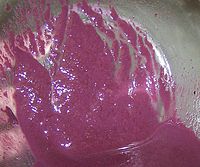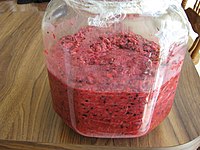31:
43:
383:
Regulation (EU) No 2019/787 of 17 April 2019 on the definition, description, presentation and labelling of spirit drinks, the use of the names of spirit drinks in the presentation and labelling of other foodstuffs, the protection of geographical indications for spirit drinks, the use of ethyl alcohol
201:, this adds a toasty, nutty "hazelnut" quality and additional depth and complexity. Chemically, this can alter the oak flavour molecules, increasing the integration, and making the oak seem less obtrusive to the palate. This is desirable because oak
212:
Muscadet is made in this fashion. The effect of the lees during bottle fermentation for at least 18 months on
Champagne is considerable. The "bready" toasty notes associated with some of the greatest sparkling wines made are the result of
281:
In a process in which yeast is added to wine that has completed primary fermentation, this secondary yeast addition typically remains in the wine from 2–8 weeks, depending on the winemaker's goals. The yeast is stirred
197:
wines are bottled directly from the lees without racking (a process for filtering the wine). In the case of great
Chardonnay, such as
402:
205:
are polyphenolic acids, and can be harsh. This process can also give an added freshness and creaminess to the wine, and improve
367:
340:
17:
384:
and distillates of agricultural origin in alcoholic beverages, and repealing
Regulation (EC) No 110/2008
382:
158:
357:
417:
8:
407:
273:, or "lees spirit", an alcoholic beverage containing a minimum of 38% alcohol by volume.
172:
86:
70:
57:
or residual yeast and other particles that precipitate, or are carried by the action of "
30:
363:
336:
102:
328:
287:
117:
412:
291:
190:
178:
131:
94:
247:
82:
396:
332:
229:
202:
130:), leading to a distinctive yeasty aroma and taste. The lees may be stirred (
98:
58:
152:
74:
225:
Beer on an element of lees (residual sediment) is also sold, such as many
42:
206:
198:
113:
286:) frequently, and racked when the protocol is complete. Also known as
303:
253:
259:
243:
234:
121:
294:
that can influence the flavour, tannins, and acidity of the wine.
148:
143:
126:
109:
124:) are sometimes aged for a time on the lees (a process known as
237:
62:
35:
290:, a light lees protocol releases additional mannoproteins and
151:
are used to impart more flavour and colour to partially aged
54:
177:"Sur lie" redirects here. For the album by Mari Hamada, see
78:
66:
108:
Normally, the wine is transferred to another container (
141:
The lees are an important component in the making of
112:), leaving this sediment behind. Some wines (notably
97:. This material is the source for most commercial
394:
323:Kassaian, Jean-Maurice (2000). "Tartaric Acid".
356:Robinson, Jancis; Harding, Julia, eds. (2015).
355:
325:Ullmann's Encyclopedia of Industrial Chemistry
376:
362:. Oxford University Press. p. 711.
322:
41:
29:
14:
395:
276:
269:Lees can also be distilled to produce
349:
316:
27:Deposits of dead yeast in wine-making
24:
101:, which is used in cooking and in
25:
429:
403:Fermentation in food processing
147:, where the leftover lees from
138:) for uptake of their flavour.
13:
1:
309:
220:
161:is made from rice wine lees.
93:or equally, as to beer only,
359:The Oxford Companion to Wine
7:
297:
10:
434:
189:literally translates from
176:
170:
164:
89:of wine and beer are the
81:at a brewery is known as
77:. The same while brewing
46:Fujian red rice wine lees
333:10.1002/14356007.a26_163
159:Fujian red wine chicken
135:
87:secondary fermentation
85:– the same from
61:", to the bottom of a
47:
39:
246:of older styles (not
53:are deposits of dead
45:
33:
327:. pp. 671–678.
288:secondary autolysis
277:Light lees protocol
262:can also be brewed
173:Yeast in winemaking
48:
40:
38:after fermentation
369:978-0-19-870538-3
240:-based ales/beers
103:organic chemistry
16:(Redirected from
425:
387:
380:
374:
373:
353:
347:
346:
320:
211:
21:
433:
432:
428:
427:
426:
424:
423:
422:
393:
392:
391:
390:
381:
377:
370:
354:
350:
343:
321:
317:
312:
300:
292:polysaccharides
279:
223:
209:
182:
179:Sur lie (album)
175:
169:
28:
23:
22:
15:
12:
11:
5:
431:
421:
420:
415:
410:
405:
389:
388:
375:
368:
348:
341:
314:
313:
311:
308:
307:
306:
299:
296:
278:
275:
257:
256:
251:
248:India Pale Ale
241:
238:Quebec, Canada
232:
230:Trappist beers
222:
219:
193:as 'on lees'.
168:
163:
26:
9:
6:
4:
3:
2:
430:
419:
416:
414:
411:
409:
406:
404:
401:
400:
398:
385:
379:
371:
365:
361:
360:
352:
344:
338:
334:
330:
326:
319:
315:
305:
302:
301:
295:
293:
289:
285:
274:
272:
267:
265:
261:
255:
252:
249:
245:
242:
239:
236:
233:
231:
228:
227:
226:
218:
216:
208:
204:
200:
196:
192:
188:
187:
180:
174:
167:
162:
160:
156:
154:
150:
146:
145:
139:
137:
133:
129:
128:
123:
119:
115:
111:
106:
104:
100:
99:tartaric acid
96:
92:
88:
84:
80:
76:
72:
68:
64:
60:
56:
52:
44:
37:
32:
19:
378:
358:
351:
324:
318:
283:
280:
270:
268:
263:
258:
224:
214:
210:and clarity.
194:
185:
184:
183:
165:
157:
153:Valpolicella
142:
140:
125:
107:
90:
71:fermentation
50:
49:
418:By-products
18:Lees (wine)
408:Winemaking
397:Categories
342:3527306730
310:References
254:Weissbiers
221:Other uses
199:Montrachet
171:See also:
114:Chardonnay
34:Lees from
304:Sake kasu
271:Hefebrand
244:Real ales
136:bâtonnage
118:Champagne
298:See also
284:bâtonage
260:Kombucha
235:Unibroue
122:Muscadet
264:sur lie
217:aging.
215:sur lie
203:tannins
195:Sur lie
186:Sur lie
166:Sur lie
149:Amarone
144:ripasso
127:sur lie
110:racking
413:Yeasts
366:
339:
191:French
132:French
120:, and
69:after
59:fining
36:Merlot
386:, §12
207:color
95:dregs
75:aging
55:yeast
364:ISBN
337:ISBN
91:lees
83:trub
79:beer
73:and
67:wine
51:Lees
329:doi
65:of
63:vat
399::
335:.
266:.
155:.
134::
116:,
105:.
372:.
345:.
331::
282:(
250:)
181:.
20:)
Text is available under the Creative Commons Attribution-ShareAlike License. Additional terms may apply.

